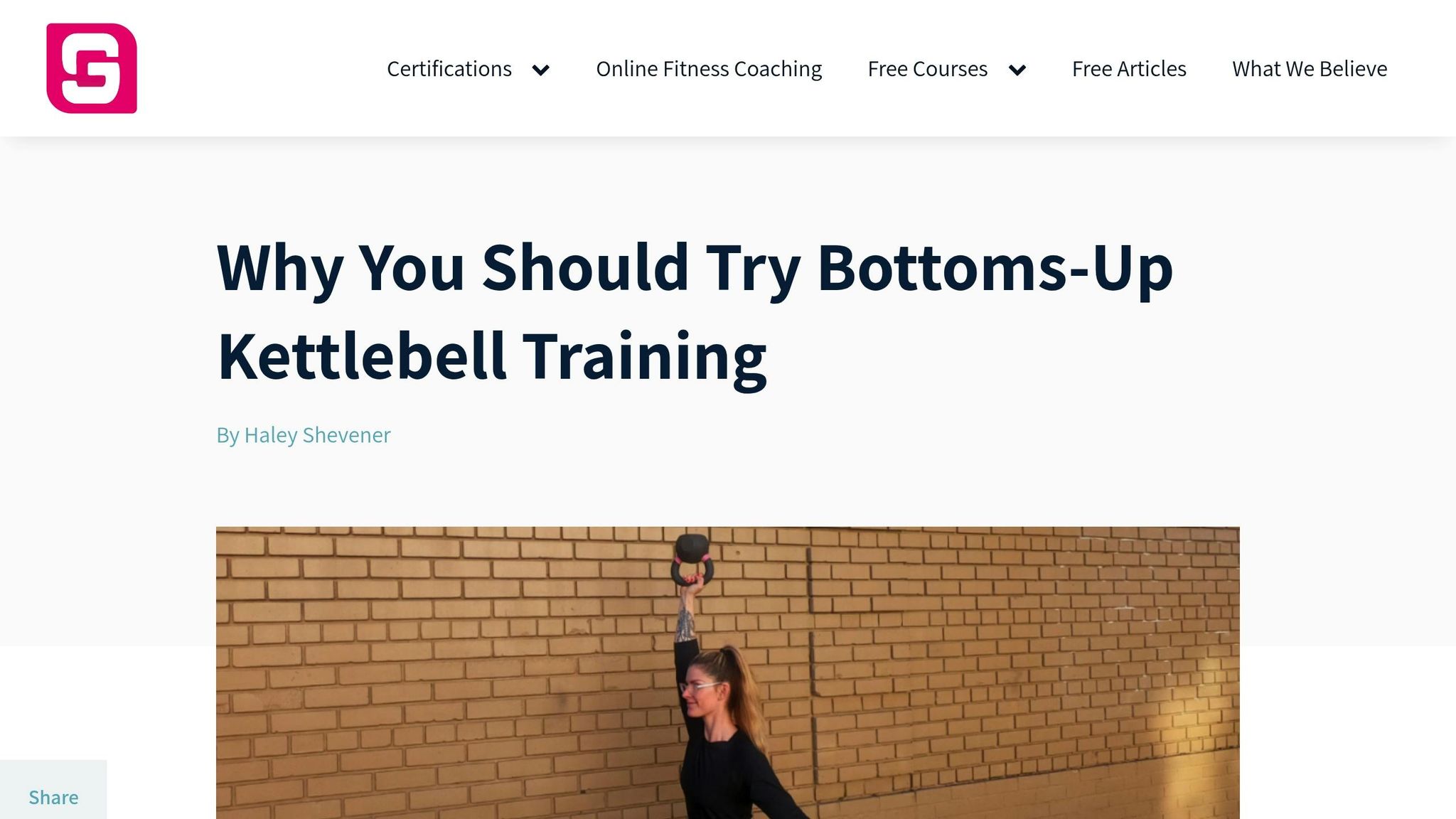Kettlebell exercises can improve shoulder recovery by building stability, mobility, and strength while protecting the spine. Stuart McGill’s method focuses on core stability and controlled movements to support long-term shoulder health. Key exercises like Turkish get-ups, windmills, and bottoms-up presses target essential muscles such as the rotator cuff and scapular stabilizers. Here’s what you need to know:
- Benefits of Kettlebells: Full-body conditioning, improved mobility, and core stability without stressing joints.
-
Key Goals:
- Core stabilization for spinal protection.
- Correcting movement patterns for better biomechanics.
- Enhancing muscle coordination and neuromuscular control.
-
Main Exercises:
- Bottoms-Up Press: Builds shoulder stability and grip strength.
- Arm Bar: Improves shoulder mobility and core engagement.
- Turkish Get-Up: Strengthens multiple muscle groups and enhances coordination.
For safe progress, start with lighter weights, focus on proper form, and consider professional guidance. McGill’s approach combines functional movement and injury prevention for effective shoulder rehabilitation.
Kettlebell Bottoms Up | Benefits, Exercises, How To Perform
Stuart McGill’s Core Rehabilitation Methods
Developing core stability plays a key role in shoulder rehabilitation by providing a solid base for upper body movements. McGill’s approach blends precise movement control with strategies to protect joints, ensuring effective and safe recovery.
Movement Control Basics
McGill’s method focuses on controlled movements that build muscular endurance while safeguarding joint health. His approach highlights isometric core exercises designed to improve:
| Movement Component | Primary Focus | Benefit for Shoulder Rehab |
|---|---|---|
| Core Stiffness | Limiting excess motion | Creates a stable base for shoulder movement |
| Neuromuscular Control | Improved coordination | Enhances shoulder blade positioning |
| Muscular Endurance | Continuous support | Reduces fatigue-related compensation |
One key concept is forming a "natural weightlifting belt", which involves synchronized contraction of core muscles to create spinal stiffness [1]. This stability is essential for safe shoulder movement and forms the foundation for further rehabilitation steps.
Joint and Spine Protection
Protecting the spine and joints is critical, and McGill emphasizes maintaining a neutral spine while allowing movement only through the hips and shoulders [1]. With research showing that 80% of people will experience lower back pain at some point [4], proper form is non-negotiable.
"Enhancing spinal stiffness is essential when looking at lifting techniques (such as deadlifting or kettlebell swings), as the function of the core limits excess motions rather than creating them." [1]
McGill’s findings link weak core stability to higher injury risks and pain [5]. His method prioritizes two key principles:
- Spine-sparing techniques: Avoiding unnecessary spinal flexion during exercises
- Core engagement: Keeping the core activated throughout movements
These elements work together to create a safer, more effective rehabilitation process.
Main Kettlebell Exercises
These kettlebell exercises are inspired by McGill’s core stability principles, particularly for shoulder rehabilitation. Each movement emphasizes controlled, progressive actions to build strength and stability.
Bottoms-Up Press Guide

The Bottoms-Up Press is a great way to test and improve shoulder stability while building grip strength. Holding the kettlebell upside down forces you to engage stabilizing muscles and maintain precise control.
| Phase | Key Action | Common Mistakes to Avoid |
|---|---|---|
| Setup | Hold the kettlebell inverted at shoulder level | Don’t let your wrist bend awkwardly |
| Press | Press the weight overhead with control | Avoid letting the kettlebell tilt |
| Return | Lower the weight slowly and steadily | Don’t rush the descent |
This exercise reinforces shoulder alignment and stability, key concepts in McGill’s approach.
Arm Bar Technique
The Arm Bar is a combination of shoulder mobility and core engagement. Research highlights its effectiveness in improving shoulder rotation and scapular mechanics [6]. Begin lying on your side with the kettlebell pressed overhead. Keep your ribcage steady, engage your core, and maintain consistent breathing – if breathing feels strained, the weight may be too heavy. This movement also helps with thoracic spine mobility [3].
Turkish Get-Up Steps
The Turkish Get-Up (TGU) is a full-body movement that enhances shoulder stability while working multiple muscle groups [7]. It takes you from lying down to standing, all while holding the kettlebell overhead.
| Movement Phase | Primary Focus | Muscles Engaged |
|---|---|---|
| Floor Press | Shoulder stability | Deltoids, rotator cuff |
| Sweep to Lunge | Core engagement | Abdominals, obliques |
| Standing Rise | Full-body integration | Glutes, quadriceps |
The TGU combines strength, coordination, and mobility, targeting nearly every major muscle group. Start with a lighter weight, around 5–10 lbs, until you master each phase of the movement [7].
sbb-itb-ed556b0
Shoulder Health Improvements
Strengthening Supporting Muscles
Kettlebell exercises are excellent for working the muscles that help your shoulders function smoothly. These workouts combine dynamic movements with stability challenges, engaging the entire shoulder area.
Here are the key muscles targeted:
- Rotator Cuff: Activated during bottom-up presses to improve stability and control.
- Scapular Stabilizers: Engaged through rows and carries, which help position the shoulder blades correctly.
- Core Muscles: Strengthened during Turkish get-ups, providing a strong base for shoulder movement.
By focusing on these muscles, you’ll create a solid foundation for better shoulder mobility.
Improving Range of Motion
Kettlebell exercises encourage natural shoulder movement through controlled, functional motions. These dynamic exercises not only address movement restrictions but also maintain joint stability, aligning with McGill’s emphasis on controlled movement.
"Improved mobility and range of motion can be obtained by teaching basic patterns of hip-joint hinging and gaining increased strength without increase of muscle mass." [2]
For beginners, it’s best to start with lighter weights – around 10 pounds – and focus on mastering correct movement patterns before increasing the load. This approach ensures safe and effective progress.
Managing Shoulder Pain
Kettlebell training isn’t just about building strength and mobility – it can also help manage shoulder pain. Ryan Jankowitz, who was diagnosed with shoulder impingement in late 2021, developed a kettlebell program to address his condition.
"This experience also reinforced the notion that kettlebell training should be considered to be a practice, not just a workout. A practice requires patience – but this will result in developing greater skills. Sometimes it’s important to slow down to go faster." [3]
Jankowitz became pain-free within six weeks, demonstrating the effectiveness of a structured kettlebell routine. Precision in technique is essential for success.
"If you completely engage the muscles of your posterior chain by digging your heels in, locking out your knees and clenching your glutes to the point where your hips extend, you won’t get injured." [2]
Safety Guidelines
When working on shoulder recovery, it’s essential to follow these safety tips to avoid injuries and make steady progress.
Weight Selection Guidelines
Choosing the right kettlebell weight is key for safe shoulder rehabilitation. If you’re recovering from an injury, lower the typical beginner weights by about 4–9 lbs to allow for a gentler progression.
| Experience Level | Push & Pull Exercises | Compound Exercises | Ballistic Exercises |
|---|---|---|---|
| Beginners – Women | 9–22 lbs | 9–26 lbs | 9–18 lbs |
| Beginners – Men | 18–26 lbs | 22–35 lbs | 13–22 lbs |
| Regular Training – Women | 18–26 lbs | 18–35 lbs | 13–22 lbs |
| Regular Training – Men | 22–35 lbs | 31–44 lbs | 18–31 lbs |
"Nothing can derail your fitness goals quicker than an injury. That’s why we recommend the kettlebell weights for beginners below (deduct 2 to 4 kg if you have nagging injuries)." – Nikolai Puchlov [8]
Once you’ve chosen the appropriate weight, focus on proper form and seek professional guidance for the best results.
Tips for Proper Form
Good form is essential to avoid further injuries while rehabbing your shoulders. Keep these tips in mind:
- Keep your heels firmly on the ground.
- Engage your core throughout the movement.
- Pull your shoulder blades down and back to maintain proper positioning.
- Control your movement speed and focus on technique.
Importance of Professional Guidance
Incorporating kettlebells into your shoulder rehab routine? A qualified instructor can make all the difference. Here’s how they can help:
- Evaluate your movement patterns.
- Tailor exercises to your specific needs.
- Monitor your technique and progress.
- Adjust your routine based on how your body responds.
"This is where expert coaching and guidance are vital in rehabilitation protocols and outcome assessments of your clients." – Perry Nickelston, DC, FMS, SFMA [2]
Summary
McGill’s kettlebell exercises offer a targeted way to improve shoulder rehabilitation by combining functional movement training with a focus on recovery and injury prevention. These exercises work multiple muscle groups and energy systems at once, creating a strong base for long-term shoulder health.
The method prioritizes precise movement mechanics and full-body involvement. This structured approach not only improves shoulder function but also helps guard against future injuries.
Here are the key benefits of this method:
- Better mobility through correct hinging techniques
- Improved strength without adding unnecessary muscle bulk
- Greater injury resistance thanks to integrated movements
"If you completely engage the muscles of your posterior chain by digging your heels in, locking out your knees and clenching your glutes to the point where your hips extend, you won’t get injured. The kettlebell can pull you off-balance only if you neglect one of those points during the swing." [2]
Achieving success in shoulder rehabilitation depends on maintaining proper form and technique. Professional guidance plays a crucial role in ensuring these exercises are performed correctly, leading to lasting improvements in shoulder health and function.


No responses yet